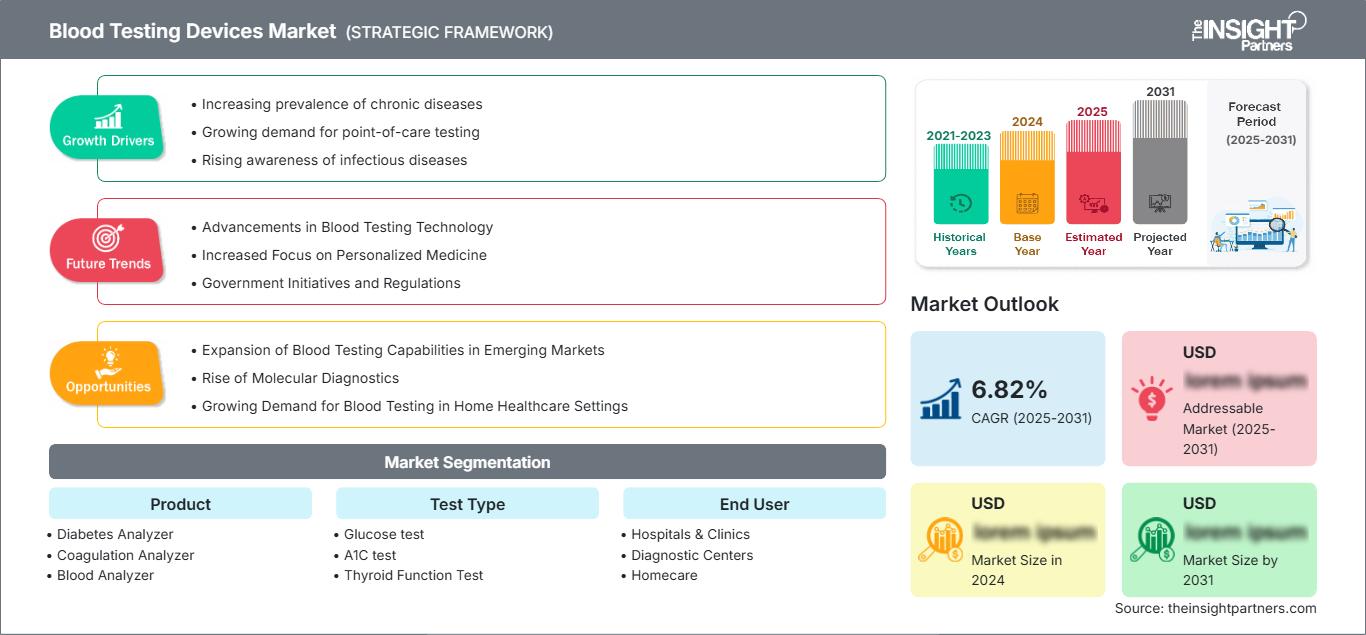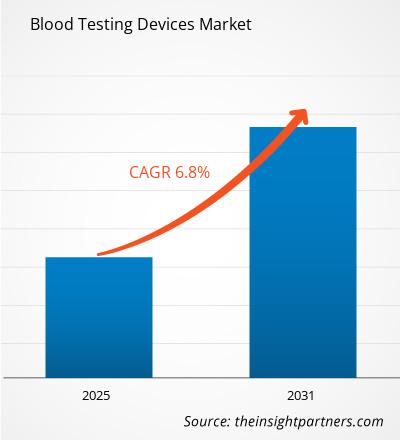Si prevede che il mercato dei dispositivi per analisi del sangue raggiungerà i 64,55 miliardi di dollari entro il 2031. Si prevede che il mercato registrerà un CAGR dell'8,7% nel periodo 2025-2031.
Il rapporto è segmentato per prodotto (analizzatore per diabete, analizzatore di coagulazione, analizzatore del sangue e analizzatore ematologico), tipo di test (test della glicemia, test A1C, test di funzionalità tiroidea, test della creatinina, test della coagulazione, emocromo completo, test LDL diretto e altri) e utente finale (ospedali e cliniche, centri diagnostici e assistenza domiciliare). L'analisi globale è ulteriormente suddivisa a livello regionale e per i principali paesi. Il rapporto offre il valore in USD per l'analisi e i segmenti sopra indicati.
Scopo del rapporto
Il rapporto "Blood Testing Devices Market" di The Insight Partners mira a descrivere il panorama attuale e la crescita futura, i principali fattori trainanti, le sfide e le opportunità. Ciò fornirà spunti a vari stakeholder aziendali, come:
- Fornitori/Produttori di tecnologia: per comprendere le dinamiche di mercato in evoluzione e conoscere le potenziali opportunità di crescita, consentendo loro di prendere decisioni strategiche informate.
- Investitori: per condurre un'analisi completa delle tendenze in merito al tasso di crescita del mercato, alle proiezioni finanziarie di mercato e alle opportunità esistenti lungo la catena del valore.
- Organismi di regolamentazione: per regolamentare le politiche e le attività di controllo sul mercato con l'obiettivo di ridurre al minimo gli abusi, preservare la fiducia degli investitori e sostenere l'integrità e la stabilità del mercato.
Segmentazione del mercato dei dispositivi per analisi del sangue
- Analizzatore per diabete
- Analizzatore di coagulazione
- Analizzatore del sangue
- Analizzatore ematologico
Tipo di test
- Test del glucosio
- Test A1C
- Test della funzionalità tiroidea
- Test della creatinina
- Test della coagulazione
- Emocromo completo
- Test LDL diretto
- Altri
Utente finale
- Ospedali e cliniche
- Centri diagnostici
- Assistenza domiciliare
Geografia
- Nord America
- Europa
- Asia-Pacifico
- Sud e America Centrale
- Medio Oriente e Africa
Potrai personalizzare gratuitamente qualsiasi rapporto, comprese parti di questo rapporto, o analisi a livello di paese, pacchetto dati Excel, oltre a usufruire di grandi offerte e sconti per start-up e università
Mercato dei dispositivi per analisi del sangue: Approfondimenti strategici

-
Ottieni le principali tendenze chiave del mercato di questo rapporto.Questo campione GRATUITO includerà l'analisi dei dati, che vanno dalle tendenze di mercato alle stime e alle previsioni.
Fattori di crescita del mercato dei dispositivi per analisi del sangue
- Crescente prevalenza di malattie croniche: negli ultimi 25 anni, l'incidenza delle malattie croniche è aumentata in tutto il mondo a causa dei cambiamenti nello stile di vita, che hanno portato a un aumento del numero di interventi chirurgici. Ad esempio, il cancro del colon-retto è uno dei tumori più comuni e letali che si sviluppano negli individui a causa dell'influenza combinata di fattori genetici e ambientali. Secondo l'Organizzazione Mondiale della Sanità (OMS), il cancro del colon-retto è stato identificato come il terzo tumore più comune e il secondo più mortale, con circa 1.926.425 casi globali nel 2022. La prevalenza di malattie croniche come diabete, cancro e malattie cardiovascolari è in aumento a livello globale, con conseguente crescente necessità di test diagnostici.
- Crescente domanda di test point-of-care: i dispositivi per test point-of-care (POCT) consentono a medici o operatori sanitari di somministrare test a domicilio del paziente o presso uno studio medico diverso da un laboratorio, limitando così i test di laboratorio esterni e migliorando l'erogazione dei servizi al paziente. La causa principale di questa tendenza è dovuta anche al progresso di tecnologie come la microfluidica, la nanotecnologia e i sistemi lab-on-a-chip. Queste tecnologie consentono di realizzare apparecchiature di analisi più piccole e avanzate, non solo portatili, ma utilizzabili da chiunque senza particolari difficoltà.
- Crescente consapevolezza delle malattie infettive: la crescente consapevolezza delle malattie infettive ha creato una maggiore necessità di dispositivi per analisi del sangue in grado di rilevare e diagnosticare queste malattie in modo rapido e accurato. Le dinamiche di trasmissione di malattie infettive come l'HIV e l'epatite hanno aumentato la domanda di dispositivi per analisi del sangue in grado di fornire una diagnosi rapida e accurata di queste malattie.
Tendenze future del mercato dei dispositivi per analisi del sangue
- Progressi nella tecnologia delle analisi del sangue: i progressi nella tecnologia delle analisi del sangue, come la miniaturizzazione, l'automazione e la digitalizzazione, consentono risultati più rapidi e accurati. Questi progressi stanno anche riducendo il costo dei dispositivi per analisi del sangue, rendendoli più accessibili a una più ampia gamma di operatori sanitari e pazienti.
- Maggiore attenzione alla medicina personalizzata: la crescente attenzione alla medicina personalizzata sta alimentando la domanda di dispositivi per analisi del sangue in grado di fornire informazioni dettagliate sul profilo genetico e sullo stato di salute di un individuo. I dispositivi per analisi del sangue possono aiutare a identificare marcatori genetici associati a determinate malattie, consentendo agli operatori sanitari di sviluppare piani di trattamento mirati.
- Iniziative e normative governative: iniziative e normative governative volte a migliorare i risultati sanitari e a ridurre i costi sanitari stanno alimentando la domanda di dispositivi per analisi del sangue. Ad esempio, i Centers for Medicare & Medicaid Services (CMS) hanno implementato nuove politiche di rimborso per i dispositivi per analisi POC, rendendoli più accessibili agli operatori sanitari.
Opportunità di mercato per i dispositivi per analisi del sangue
- Espansione delle capacità di analisi del sangue nei mercati emergenti: con lo sviluppo delle infrastrutture sanitarie nei mercati emergenti, cresce la domanda di dispositivi per analisi del sangue in grado di diagnosticare e monitorare una serie di malattie, tra cui malattie infettive e cancro.
- Ascesa della diagnostica molecolare: lo sviluppo di tecnologie di diagnostica molecolare, come la PCR (reazione a catena della polimerasi) e i test basati sulla PCR, potrebbe consentire un rilevamento più accurato e sensibile di malattie genetiche e agenti infettivi. Inoltre, si prevede che i crescenti investimenti da parte del governo e degli attori pubblici nella diagnostica molecolare aumenteranno le opportunità di collaborazioni e alleanze.
- Crescente domanda di analisi del sangue in ambito sanitario domiciliare: la crescente tendenza verso l'assistenza sanitaria domiciliare e il monitoraggio remoto dei pazienti potrebbe stimolare la domanda di dispositivi portatili e facili da usare per le analisi del sangue, che possono essere utilizzati nelle case dei pazienti.
Mercato dei dispositivi per analisi del sangue
Le tendenze regionali e i fattori che influenzano il mercato dei dispositivi per analisi del sangue durante il periodo di previsione sono stati ampiamente spiegati dagli analisti di The Insight Partners. Questa sezione illustra anche i segmenti di mercato e la geografia della gestione delle malattie del ritmo cardiaco in Nord America, Europa, Asia-Pacifico, Medio Oriente e Africa, America meridionale e centrale.
Ambito del rapporto di mercato sui dispositivi per analisi del sangue
| Attributo del rapporto | Dettagli |
|---|---|
| Dimensioni del mercato in 2024 | US$ XX Billion |
| Dimensioni del mercato per 2031 | US$ 64.55 Billion |
| CAGR globale (2025 - 2031) | 8.7% |
| Dati storici | 2021-2023 |
| Periodo di previsione | 2025-2031 |
| Segmenti coperti |
By Prodotto
|
| Regioni e paesi coperti |
Nord America
|
| Leader di mercato e profili aziendali chiave |
|
Densità degli operatori del mercato dei dispositivi per analisi del sangue: comprendere il suo impatto sulle dinamiche aziendali
Il mercato dei dispositivi per analisi del sangue è in rapida crescita, trainato dalla crescente domanda degli utenti finali, dovuta a fattori quali l'evoluzione delle preferenze dei consumatori, i progressi tecnologici e una maggiore consapevolezza dei benefici del prodotto. Con l'aumento della domanda, le aziende stanno ampliando la propria offerta, innovando per soddisfare le esigenze dei consumatori e sfruttando le tendenze emergenti, alimentando ulteriormente la crescita del mercato.

- Ottieni il Mercato dei dispositivi per analisi del sangue Panoramica dei principali attori chiave
Punti di forza
- Copertura completa: il rapporto copre in modo completo l'analisi di prodotti, servizi, tipologie e utenti finali del mercato dei dispositivi per analisi del sangue, fornendo un panorama olistico.
- Analisi di esperti: il rapporto è compilato sulla base della conoscenza approfondita di esperti e analisti del settore.
- Informazioni aggiornate: il rapporto garantisce rilevanza aziendale grazie alla sua copertura di informazioni recenti e tendenze dei dati.
- Opzioni di personalizzazione: questo rapporto può essere personalizzato per soddisfare le esigenze specifiche del cliente e adattarsi in modo appropriato alle strategie aziendali.
Il rapporto di ricerca sul mercato dei dispositivi per analisi del sangue può, quindi, aiutare a guidare il percorso di decodificazione e comprensione dello scenario del settore e delle prospettive di crescita. Sebbene possano esserci alcune preoccupazioni valide, i vantaggi complessivi di questo rapporto tendono a superare gli svantaggi.
- Analisi storica (2 anni), anno base, previsione (7 anni) con CAGR
- Analisi PEST e SWOT
- Valore/volume delle dimensioni del mercato - Globale, Regionale, Nazionale
- Industria e panorama competitivo
- Set di dati Excel
Report recenti
Rapporti correlati
Testimonianze
Motivo dell'acquisto
- Processo decisionale informato
- Comprensione delle dinamiche di mercato
- Analisi competitiva
- Analisi dei clienti
- Previsioni di mercato
- Mitigazione del rischio
- Pianificazione strategica
- Giustificazione degli investimenti
- Identificazione dei mercati emergenti
- Miglioramento delle strategie di marketing
- Aumento dell'efficienza operativa
- Allineamento alle tendenze normative






















 Ottieni un campione gratuito per - Mercato dei dispositivi per analisi del sangue
Ottieni un campione gratuito per - Mercato dei dispositivi per analisi del sangue